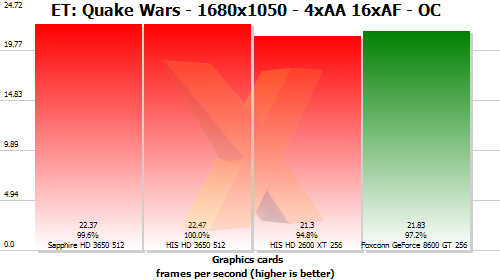High-def playback, power-draw, temperature readings, overclocking
High-def. playback
These ~£50 cards offer more than just reasonable 3D performance, though, and hardware-based decode of high-def. content is one area that's becoming increasingly important as users look to use their desktop systems for media-rich playback.Using an Intel Core 2 Quad Q6700 as the base CPU, chapter six of the VC1-encoded Harry Potter and the Goblet of Fire HD DVD was run via HD DVD-supporting PowerDVD (Ultra 7.3.3501)
| Graphics cards | Sapphire Radeon HD 3650 512MiB OC | Foxconn GeForce 8600 GT OC 256MiB |
|---|---|---|
| Average CPU utilisation % | 7.54 | 16.18 |
The ATI-based Radeon HD 3650 is better than its NVIDIA counterpart at decoding the content, but, and this is the important point, neither place a substantial load on the CPU - it gets away by doing the bare minimum of work. VC-1 doesn't feature the real CPU-killer, CABAC binary decompression.
Power-draw musings
Using the system setups detailed on page six, we measured the idle and load power-draw readings from the system, with both idle and load readings noted down. The Canyon test from 3DMark06 was run at 1,920x1,200 4xAA 16xAF for the under-load figures, incidentally.| Graphics cards | Sapphire Radeon HD 3650 512MiB OC | Foxconn GeForce 8600 GT OC 256MiB |
|---|---|---|
| Power-draw idle (system) | 89 | 113 |
| Power-draw load (system) | 157 | 168 |
The Radeon-based system produces a substantially lower idle power-draw, thanks to, in the main, PowerPlay on the desktop, but that benefit is largely wiped out when under gaming load. There's nothing much in it, really.
Temperature musings
| Graphics cards | Sapphire Radeon HD 3650 512MiB OC | HIS Radeon HD 3650 IceQ Turbo 512MiB | Foxconn GeForce 8600 GT OC 256MiB |
|---|---|---|---|
| Ambient temperature | 21°C | 19°C | 22°C |
| Idle temperature | 40°C | 42°C | 44°C |
| Load temperature | 61°C | 51°C | 63°C |
| Ambient-to-load delta | 40°C | 32°C | 41°C |
The idle and load temperature readings are close enough. Please note that the Foxconn card was tested on a different platform and its temperature results will, most likely, be reported to be just a touch lower than expected.
The HIS card's IceQ cooler is the best of the bunch, clearly, so let's see how it impacts upon overclocking.
Overclocking
The Sapphire card was successfully overclocked from 800/1,800MHz to 850.5/2,070MHz. The overclocked memory speed, in particular, was impressive.The better cooling on the HIS card saw engine and shader clocks pushed up to 877.5MHz but memory faltered at anything above 1,908MHz.

The overclock gives around 10 per cent more performance than the standard showing, highlighted on page eight. Engine and shader speed is worth more than memory bandwidth here.









